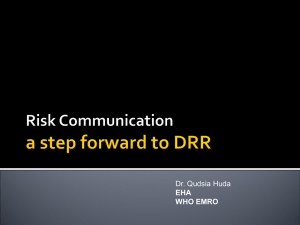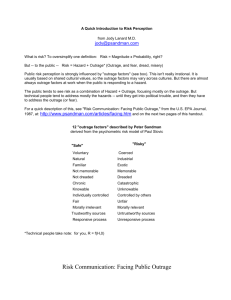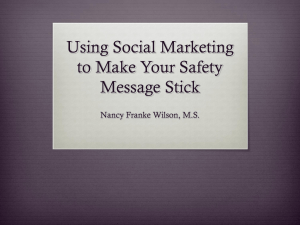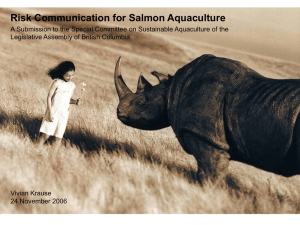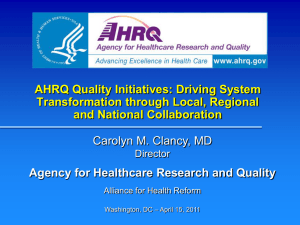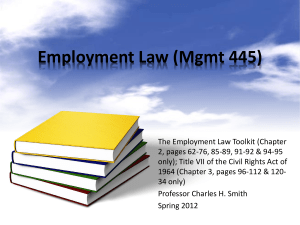PowerPoint Slides - UNC Center for Public Health Preparedness
advertisement
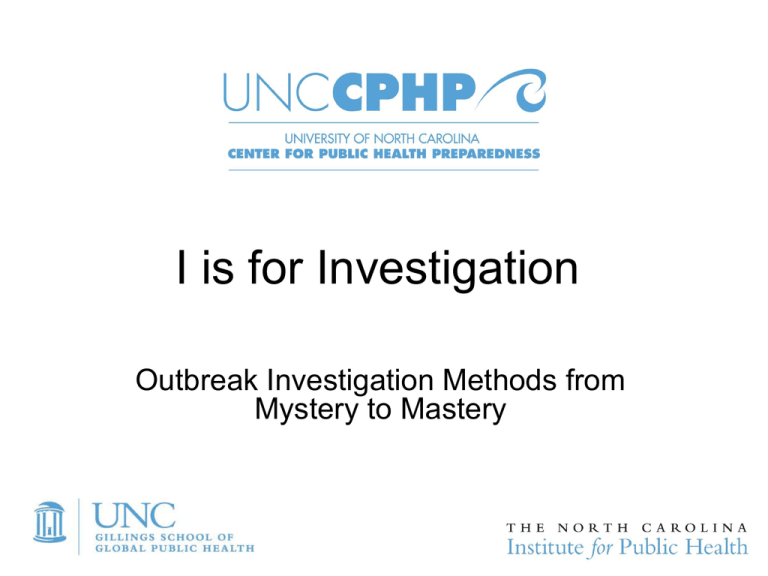
I is for Investigation Outbreak Investigation Methods from Mystery to Mastery Session VII Risk and Crisis Communication Session Overview • What is risk communication? • Risk communication theories • Risk communication strategies Learning Objectives • Define risk communication • Identify theories of risk communication • Understand basic strategies for implementing risk communication • Understand components of a risk communication message What is Risk Communication? Types of Risk Communication • Health communication • Crisis communication • Risk communication • Emergency risk communication Health Communication • Study and use of communication strategies to inform and influence decisions that enhance health • Example messages – Eat a balanced diet – Ensure children are active Crisis Communication • Providing information about an event that occurs unexpectedly • Efforts by community leaders to inform the public about a crisis and how to react • Organization is experiencing the crisis and must respond Risk Communication • Addresses possible adverse outcomes and probability of that outcome occurring for an individual • Examples – Choose between medical treatment options – Choose to reside near chemical plant – Understand possible outcomes of past exposure Emergency Risk Communication • An expert opinion to benefit its receivers and promote a behavior or action that allows for rapid and efficient recovery from the event • Communicator is not a participant in the crisis • Allows individual or community to make the best possible decisions Communication: Health vs. Risk vs. Crisis • Health: prevent disease, promote good health behaviors—long time frame • Risk communication: inform the public – Provide information about health effects – Identify the hazard, explain the situation • Crisis communication: – Includes all the concerns above but higher emotional component, shorter time frame Risk Communication Theories Perception of Risk • Risk = Hazard + Outrage • Outrage factors – Voluntariness and controllability – Effects on children – Familiarity – Media attention – Fairness – Benefits – Catastrophic potential – Dread – Personal stake – Human vs. natural origin Address Outrage Factors • People weigh outrage according to their values • Reducing outrage will help to reduce perceived risk Trust Determination Theory • When people are upset – They often distrust that others care – They doubt credibility of information • Higher emotion / distrust requires more empathetic communication – “We are all concerned about…” – “I understand that you are worried about…” Trust Determination Theory • Credibility – Typically high for health professionals – Based on perception as empathetic and caring – Determined within the first 9-30 seconds Image Source: FEMA Building Trust: Body Language • Body language can override verbal communication – Use good eye contact – Keep your voice low and calm – Don’t sit back in your chair – Don’t cross your arms across your chest – Don’t touch your hands to your face – Don’t drum or tap your hands or feet – Don’t rest your head in your hand Mental Noise Theory • When people are upset they have difficulty hearing, understanding, and remembering Risk Communication Tips • Don’t let the issue be defined by someone else – Listen to the public early – Identify and address areas of possible controversy • Meet the needs of the media • Work with other credible sources • Plan carefully and evaluate your efforts Risk Communication Tips • Accept and involve the public as a partner – Give people a chance to express their concerns – Allow the public to decide how much risk to bear • Listen to the public's concerns – Emphasize trust, credibility, fairness – Provide technical details, but respond to other concerns as well Risk Communication Tips • Speak clearly and with compassion – Acknowledge illness, injury, death • Be honest, frank, and open – Release and discuss information, even if there are no solutions – Involve communities Why should I worry about communication? This isn’t my job! You have a responsibility to the public. Integrate risk communication into your job and help others do the same. Risk Communication Strategies Reduce Mental Noise • Keep each key message brief: 10 seconds or 30 words • Repeat messages • Use easy to understand visual aids • Avoid unnecessary use of “negative” words such as “no” • Use message mapping to create up to 3 key messages with supporting statements Example: Message Maps Question: How contagious is smallpox? Key Message 1 Key Message 2 Key Message 3 Smallpox spreads slowly compared to measles or influenza The slow spread allows time for us to trace contacts and vaccinate exposed people Vaccination within 3 to 4 days of contact will generally prevent the disease Message Map and Communications Resource “Communication in Risk Situations: Responding to the Challenges” http://www.astho.org/WorkArea/DownloadAsset.as px?id=5602 Anticipate Questions • Prepare and practice! Anticipate Questions from the Media • • • • • • • • Who is in charge? What are you doing about the problem? Is the problem being contained? What should we do? Why did this happen? Why wasn’t this prevented from happening? What else can go wrong? When did you begin working on this? http://archive.ahrq.gov/research/health/happd.htm Be Prepared for Questions • Practice responses • Emphasize key messages • Keep answers short and focused • Practice selfmanagement • Speak and act with integrity Image Source: FEMA Preparing for an Interview Ask questions of the media: • Does the reporter specialize in an area? • Who else has the reporter interviewed? • What is the focus of the interview? • How long will the interview take? • Where and when will the story appear? • Will the reporter call back to verify the accuracy of quotes attributed to the person interviewed? Considerations for Message Development Audience Purpose of Message Demographics Give facts / update Relationship to event Rally to action Level of Clarify event outrage status Address rumors Satisfy media requests Method of Delivery Spokesperson (TV, other) Print media Web Radio Messages Should Provide Information About. . . • • • • • An infectious disease agent Related symptoms How the disease spreads Vaccine or treatment information Instructions to prevent and reduce transmission and exposure • The number of cases and their status Basic Message Components in 30 Seconds 1. Expression of empathy and caring 2. Confirmed facts – Who, what, when, where, why, how 3. 4. 5. 6. What you don’t know about the situation Process to deal with the problem Statement of commitment Where people can get more information Example: Scenario • A virulent strain of Type A influenza has caused 1500 infections and 150 deaths in Southeast Asia • In the past 3 days, people have become ill in New York and Los Angeles • Today, 30 local area residents were admitted to the hospital; lab results will be available in 12-24 hours • No vaccines or drugs are known to be effective • Symptoms are treatable with supportive medical care • Assuming that this is the same Type A strain reported in Asia and major U.S. cities • Public health professionals are working closely with hospitals and medical staff to identify additional cases Example: Create a Message 1. Express empathy and caring “We’ve all been hearing news about the flu, and we’re concerned about what we might be facing in our communities.” 2. Confirm facts “Today, 30 people were admitted to hospitals with high fever, difficulty breathing, and severe pneumonia.” Example: Create a Message 3. What you don’t know about the situation “We suspect it is the same influenza that has recently appeared in southeast Asia and parts of the U.S., but we cannot conclusively identify the disease at this time.” 4. Process to deal with the problem “However, specimens have been sent to the state laboratory and we are awaiting the results. In the meantime, we have brought together the best medical and scientific expertise to care for the sick, learn the cause of their illness, and if it is a contagious disease, work to keep it from spreading.” Example: Create a Message 5. Statement of commitment “This is a process that is going to take time. We will update the public on any information on at least a daily basis.” 6. Where people can get more information “We have established a public health hotline to answer people’s questions and have important information on our Web site. The number to call is 1-800-555-1FLU, or visit www.FluInfo.gov.” CDC Motto for Risk Communication “Be first. Be right. Be credible.” Session VII Summary • Risk communication provides information about expected outcomes resulting from a behavior or exposure • Crisis communication is an effort to inform the public about a crisis and how to react • Emergency risk communication attempts to provide information to people so they can make decisions Session VII Summary • Take theories into account – Defining risk – Trust determination – Mental noise • Implementing risk communication includes: – – – – – Having a plan before the crisis arises Listening to the public Responding to media requests Preparing for questions Paying attention to body language Session VII Summary • During a crisis, people will be frightened and seek information, guidance, and reassurance • Communication should be open and honest • Communication should respect the rights of the public to gain information, ask questions, and disagree with the experts Session VII Summary • Keep messages clear, short, consistent, and memorable • Speak with compassion and show your personal concern, in addition to presenting facts and instructions References and Resources • Association of State and Territorial Health Officials. (2011) “Communication in Risk Situations: Responding to the Challenges.” Available from: http://www.astho.org/WorkArea/DownloadAsset.aspx?id=5602. • Agency for Healthcare Research and Quality (AHRQ) Archive from: Covello, V.T. Keeping Your Head in a Crisis: Responding to Communication Challenges Posted by Bioterrorism and Emerging Infectious Diseases. Association of State and Territorial Health Officers (ASTHO), 2002. Accessed November 2012. Available from: http://archive.ahrq.gov/research/health/happd.htm • Centers for Disease Control and Prevention. Crisis, Emergency, and Risk Communication. 2008. Available from: http://emergency.cdc.gov/cerc/pdf/cerc_guide_basic.pdf • Centers for Disease Control and Prevention. CDCynergy: Gateway to Health Communication and Social Marketing Practice. Available at: www.cdc.gov/healthcommunication/CDCynergy/ References and Resources • Covello,V. and Sandman, P. (2001). Risk Communication: Evolution and Revolution. In:Wolbarst A., ed. Solutions to an Environment in Peril. Baltimore, MD: John Hopkins University Press: 164-178. Available from: http://www.psandman.com/articles/covello.htm. • Sandman, P. (2004) Crisis Communication: A Very Quick Introduction. Available from: http://www.psandman.com/col/crisis.htm. • Sandman, P. (2003) Dilemmas in Emergency Communication Policy. Emergency Risk Communication CDCynergy (CD-ROM). Atlanta, GA: Centers for Disease Control and Prevention. Available from: http://www.psandman.com/articles/dilemmas.pdf. • Sandman, P. (2003) Four Kinds of Risk Communication. Available from: http://www.psandman.com/col/4kind-1.htm.
